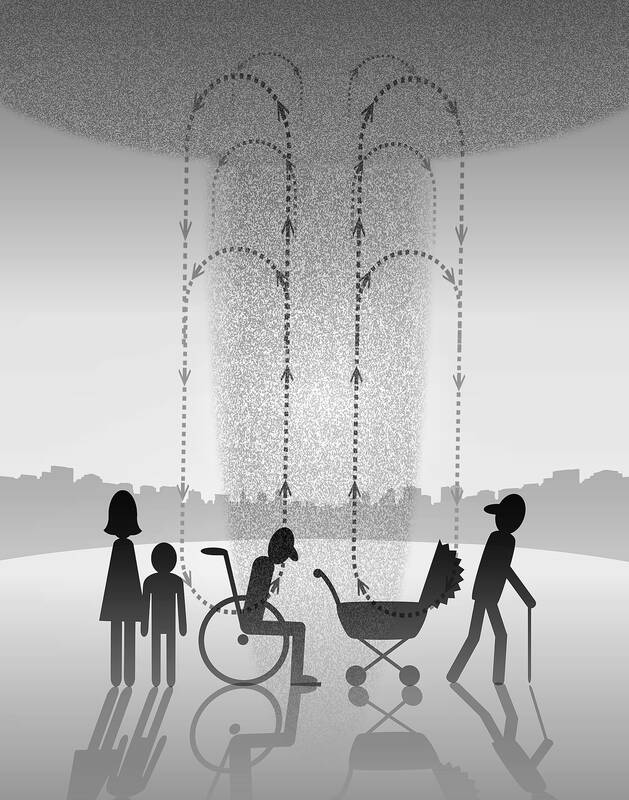Here is a fact that might make people feel a little strange inside: Everyone has plastic in our brains. Tiny particles of polymers are also hanging about in everyone’s livers, kidneys, hearts and bloodstream. If that does not make your insides itch, consider that in just eight years, scientists have observed an increase in the amount of bodily plastic. A study published in Nature compared postmortem organ samples from autopsy specimens obtained in 2016 and last year. The more recent cadavers had far higher concentrations in the liver and brain.
Are all steadily becoming part-plastic (even a newborn baby contains plastic these days)? What harm could such tiny particles do? Akin to climate change’s image of a polar bear on a lone ice float, the poster children of the plastic crisis thus far have been marine creatures choking on straws and carrier bags. The images are emotive, but have kept the issue at arm’s length — a problem for the deep sea. In reality, it is so much worse than most people think.
The Lancet, a peer-reviewed medical journal, has laid out the problem definitively, calling plastics a “grave, growing and under-recognized danger” in a paper published last week launching a global monitoring system to track progress on mitigating the harms.

Illustration: Yusha
Plastics are certainly useful. Their development has supported advances in fields such as medicine, engineering and electronics. They have enabled the use of sterile, single-use catheters and syringes, which reduce the risk of infection. They are lightweight, making cars and other vehicles more fuel efficient. They make insulating and housing electronics safer.
Because the costs to the environment and human health are externalized, the material is cheap — allowing access for the convenience of a takeaway coffee or affordable clothing.
However, the problem is becoming so much worse with humans’ addiction to nonbiodegradable polymers. Global annual plastic production has soared to 475 million tonnes in 2022 from just 2 million tonnes in 1950. Half of all the plastic ever made has been produced since 2010 and, without intervention, 1.2 billion tonnes of the stuff would likely be made every year by 2060.
Because plastics do not break down — they simply fragment into smaller particles — that is billions of tonnes that would be added to ecosystems, waters and bodies.
There are many ways plastic is bad for people’s health. More than 16,000 chemicals can be present in plastics such as flame retardants, per- and polyfluoroalkyl substances and phthalates. Health impacts from exposure to such chemicals are wide-ranging and occur at every age, from miscarriages and reduced birthweight to cardiovascular disease and cancer.
What is worse is that hazard data is not available publicly for more than two-thirds of known plastic chemicals, meaning we have no idea how they could be harming us.
As well as tainting people with chemicals, the tiny fragments of the polymers — micro- and nanoplastics — are accumulating in people’s bodies, bypassing their built-in protective mechanisms such as the blood-brain barrier and placenta. Research is in the early stages, but already links have been suggested between microplastics and lung disease, inflammatory bowel disease and strokes, among other conditions.
Then there are some near-bizarre unintended health consequences. For example, who would have guessed that plastic waste would contribute to the increasing spread of vector-borne diseases such as dengue and Zika virus infection, by providing favorable environments for Aedes mosquitoes to lay their eggs?
Likewise, a study from the University of Exeter and Plymouth Marine Laboratory found numerous links between plastic and antimicrobial resistance. Spills of crude oil, the starting point for many types of plastic, have been found to help bacteria become resistant to antibiotics, a process augmented by the chemicals added to plastic, such as bisphenols and phthalates.
Knowing all of this, people are attempting to limit their plastic exposure. Actor Orlando Bloom even splashed out US$13,000 on an experimental blood-cleansing treatment.
Honestly, it is futile.
This morning, I went for a run. Everything from my sports bra to my shoes was made of a mix of synthetic materials including polyester and nylon. Afterward, I squeezed toothpaste from a polyethylene tube. I cycled to work, inhaling microplastics formed by tire wear and road erosion.
I have not been nearly organized enough to meal prep, so I often pop out to buy lunch, which would likely involve some single-use plastic. Later, I might have a cup of tea, and the bag would have plastic in it.
That is likely a fraction of the plastic I am exposed to on a daily basis. Some of these things are within my control, but living a truly plastic-free life in the modern world is impossible.
Nations are hashing out a global plastics treaty in Geneva, Switzerland, after last year failing to reach an agreement in Busan, South Korea. It is imperative that they leave with strong legally binding commitments to tackle the problem.
Sadly, they are not starting from a promising place: In Busan, nations split into two coalitions — a high-ambition group that advocated for phasing out harmful plastics and chemicals, and a coalition of oil-producing countries, such as Russia and Saudi Arabia, which wanted the treaty to focus on waste management and recycling. Each side became so entrenched that delegates could not even agree on voting rules.
A strong treaty should impose limits on plastic production, regulate the use of hazardous chemicals within plastic, phase out single-use products and commit to improving recycling and waste management. It should also recognize the multitude of adverse health effects that the production, use and disposal of polymers are having on people.
After all, plastic pollution does not just threaten sea turtles. It is also a clear and present danger to human health.
Lara Williams is a Bloomberg Opinion columnist covering climate change. This column reflects the personal views of the author and does not necessarily reflect the opinion of the editorial board or Bloomberg LP and its owners.

“History does not repeat itself, but it rhymes” (attributed to Mark Twain). The USSR was the international bully during the Cold War as it sought to make the world safe for Soviet-style Communism. China is now the global bully as it applies economic power and invests in Mao’s (毛澤東) magic weapons (the People’s Liberation Army [PLA], the United Front Work Department, and the Chinese Communist Party [CCP]) to achieve world domination. Freedom-loving countries must respond to the People’s Republic of China (PRC), especially in the Indo-Pacific (IP), as resolutely as they did against the USSR. In 1954, the US and its allies
A response to my article (“Invite ‘will-bes,’ not has-beens,” Aug. 12, page 8) mischaracterizes my arguments, as well as a speech by former British prime minister Boris Johnson at the Ketagalan Forum in Taipei early last month. Tseng Yueh-ying (曾月英) in the response (“A misreading of Johnson’s speech,” Aug. 24, page 8) does not dispute that Johnson referred repeatedly to Taiwan as “a segment of the Chinese population,” but asserts that the phrase challenged Beijing by questioning whether parts of “the Chinese population” could be “differently Chinese.” This is essentially a confirmation of Beijing’s “one country, two systems” formulation, which says that
On Monday last week, American Institute in Taiwan (AIT) Director Raymond Greene met with Chinese Nationalist Party (KMT) lawmakers to discuss Taiwan-US defense cooperation, on the heels of a separate meeting the previous week with Minister of National Defense Minister Wellington Koo (顧立雄). Departing from the usual convention of not advertising interactions with senior national security officials, the AIT posted photos of both meetings on Facebook, seemingly putting the ruling and opposition parties on public notice to obtain bipartisan support for Taiwan’s defense budget and other initiatives. Over the past year, increasing Taiwan’s defense budget has been a sore spot
Media said that several pan-blue figures — among them former Chinese Nationalist Party (KMT) chairwoman Hung Hsiu-chu (洪秀柱), former KMT legislator Lee De-wei (李德維), former KMT Central Committee member Vincent Hsu (徐正文), New Party Chairman Wu Cheng-tien (吳成典), former New Party legislator Chou chuan (周荃) and New Party Deputy Secretary-General You Chih-pin (游智彬) — yesterday attended the Chinese Communist Party’s (CCP) military parade commemorating the 80th anniversary of the end of World War II. China’s Xinhua news agency reported that foreign leaders were present alongside Chinese President Xi Jinping (習近平), such as Russian President Vladimir Putin, North Korean leader Kim